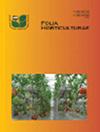Development of dandelion (Taraxacum spp.) quality evaluation technology based on phenolic acids
IF 2.2
4区 农林科学
Q2 HORTICULTURE
引用次数: 0
Abstract
Abstract One of the main purposes for which dandelions are cultivated is to derive phenolic acids from their processing. Phenolic acids, which are one of the main useful compounds in dandelion, constitute one of the important groups of therapeutically significant bioactive compounds in traditional Chinese medicine. To carry out a relatively full evaluation of dandelion quality, it was found advisable to use multiple indices to avoid conflict with the single evaluation index stipulated by China Pharmacopoeia. Thus, a quality evaluation method was created based on traditional Chinese medicinal theory and relevant statistics on phenolic acids. Firstly, four main kinds of phenolic acids – caftaric acid, chlorogenic acid, caffeic acid and cichoric acid – were chosen as the main indices for quality evaluation through the optimisation of high performance liquid chromatography detection conditions and fingerprint comparison analysis; then, the content of each component was divided into five levels based on the descriptive statistics of 578 dandelion samples and references; finally, the equal weight average method was used to convert content levels of the four components into a comprehensive quality index, which served as the means for dandelion quality to be identified and segregated into grades, as follows: Grade 1 (super high, probability of 0.8%), Grade 2 (high, 18.72%), Grade 3 (medium, 37.28%), Grade 4 (qualified, 32%) and Grade 5 (low, 11.2%). This method is the first to comprehensively evaluate dandelion quality for setting an industry standard in China, and has practical and scientific characteristics.基于酚酸的蒲公英品质评价技术的发展
摘要栽培蒲公英的主要目的之一是从其加工过程中提取酚酸。酚酸是蒲公英中主要有用的化合物之一,是中药中具有重要治疗意义的生物活性化合物之一。为了对蒲公英的质量进行比较全面的评价,建议采用多个指标,避免与《中国药典》规定的单一评价指标相冲突。因此,建立了一种基于中药理论和酚酸相关统计数据的质量评价方法。首先,通过优化高效液相色谱检测条件和指纹图谱对比分析,选择咖啡酸、绿原酸、咖啡酸和菊苣酸四种主要酚酸作为质量评价指标;然后,根据578份蒲公英样品和参考文献的描述性统计,将各成分的含量分为五个层次;最后,采用等重平均法将四种成分的含量水平转换为综合质量指数,作为蒲公英质量的识别和分级手段,分为:1级(超高,概率0.8%)、2级(高,18.72%)、3级(中等,37.28%),4级(合格,32%)和5级(低,11.2%)。该方法是国内首个为制定行业标准而对蒲公英质量进行综合评价的方法,具有实用性和科学性。
本文章由计算机程序翻译,如有差异,请以英文原文为准。
求助全文
约1分钟内获得全文
求助全文
来源期刊

Folia Horticulturae
Agricultural and Biological Sciences-Horticulture
CiteScore
3.40
自引率
0.00%
发文量
13
审稿时长
16 weeks
期刊介绍:
Folia Horticulturae is an international, scientific journal published in English. It covers a broad research spectrum of aspects related to horticultural science that are of interest to a wide scientific community and have an impact on progress in both basic and applied research carried out with the use of horticultural crops and their products. The journal’s aim is to disseminate recent findings and serve as a forum for presenting views as well as for discussing important problems and prospects of modern horticulture, particularly in relation to sustainable production of high yield and quality of horticultural products, including their impact on human health.
 求助内容:
求助内容: 应助结果提醒方式:
应助结果提醒方式:


